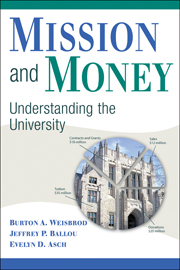Book contents
- Frontmatter
- Contents
- Illustrations
- Preface
- 1 An Introduction to the Higher Education Industry
- 2 The Higher Education Business and the Business of Higher Education – Now and Then
- 3 Is Higher Education Becoming Increasingly Competitive?
- 4 The Two-Good Framework: Revenue, Mission, and Why Colleges Do What They Do
- 5 Tuition, Price Discrimination, and Financial Aid
- 6 The Place of Donations in Funding the Higher Education Industry
- 7 Endowments and Their Management: Financing the Mission
- 8 Generating Revenue from Research and Patents
- 9 Other Ways to Generate Revenue – Wherever It May Be Found: Lobbying, the World Market, and Distance Education
- 10 Advertising, Branding, and Reputation
- 11 Are Public and Nonprofit Schools “Businesslike”? Cost-Consciousness and the Choice between Higher Cost and Lower Cost Faculty
- 12 Not Quite an Ivory Tower: Schools Compete by Collaborating
- 13 Intercollegiate Athletics: Money or Mission?
- 14 Mission or Money: What Do Colleges and Universities Want from Their Athletic Coaches and Presidents?
- 15 Concluding Remarks: What Are the Public Policy Issues?
- Appendix
- References
- Index
6 - The Place of Donations in Funding the Higher Education Industry
Published online by Cambridge University Press: 17 July 2009
- Frontmatter
- Contents
- Illustrations
- Preface
- 1 An Introduction to the Higher Education Industry
- 2 The Higher Education Business and the Business of Higher Education – Now and Then
- 3 Is Higher Education Becoming Increasingly Competitive?
- 4 The Two-Good Framework: Revenue, Mission, and Why Colleges Do What They Do
- 5 Tuition, Price Discrimination, and Financial Aid
- 6 The Place of Donations in Funding the Higher Education Industry
- 7 Endowments and Their Management: Financing the Mission
- 8 Generating Revenue from Research and Patents
- 9 Other Ways to Generate Revenue – Wherever It May Be Found: Lobbying, the World Market, and Distance Education
- 10 Advertising, Branding, and Reputation
- 11 Are Public and Nonprofit Schools “Businesslike”? Cost-Consciousness and the Choice between Higher Cost and Lower Cost Faculty
- 12 Not Quite an Ivory Tower: Schools Compete by Collaborating
- 13 Intercollegiate Athletics: Money or Mission?
- 14 Mission or Money: What Do Colleges and Universities Want from Their Athletic Coaches and Presidents?
- 15 Concluding Remarks: What Are the Public Policy Issues?
- Appendix
- References
- Index
Summary
The private enterprise segment of the economy in any industry is almost entirely dependent on revenue from sale of goods and services. Donations are of no consequence. Not only is there no tax incentive for people to give to Macy's or General Motors – or, for that matter, to a for-profit school such as the University of Phoenix – but it is most difficult for a prospective donor to have reasonable assurance that a donation would be used in any way other than to advance the interests of shareholders or managers.
The higher education industry is not really different. The 2,680 for-profit schools – most of which are “career academies” that do not offer a four-year baccalaureate degree or even a two-year associate degree (see Table A2.2 in the Appendix) – are like their for-profit counterparts throughout the economy. They receive virtually no donations; less than one-third of 1 percent of their total revenues is from contributions (see Table 2.1). And like other for-profit firms they are overwhelmingly dependent on revenue from sales to their “customers” – that is, from tuition.
But the traditional, public and private nonprofit colleges and universities are another matter. They depend heavily on donations – what the IRS calls “contributions, gifts, and grants” – especially from state and local governments in the case of public universities and community colleges and on individual and corporate contributions in the case of nonprofit higher education, as a look at Tables 2.1 and Appendix Tables A2.4 and A2.5 shows.
- Type
- Chapter
- Information
- Mission and MoneyUnderstanding the University, pp. 102 - 129Publisher: Cambridge University PressPrint publication year: 2008

